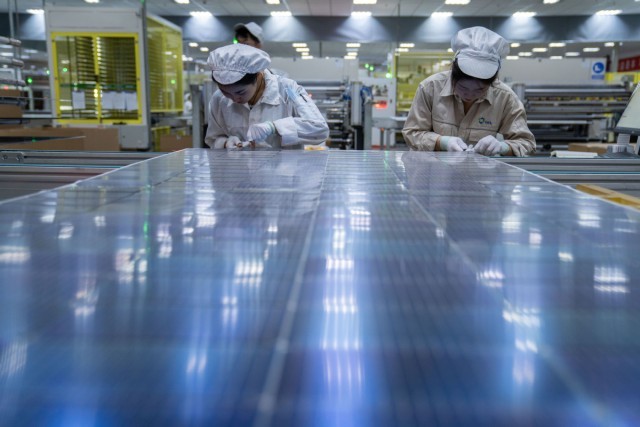
Employees work at a photovoltaic panel production facility in Hefei, Anhui province, in February. [RUAN XUEFENG/FOR CHINA DAILY]
China's large-scale production of solar panels and electric vehicles has not only lowered costs but has also made green technology more accessible globally, industry insiders said.
The nation's optimum production capacity has helped other countries and regions reduce their burden in terms of production costs and technological development, said Ma Yinqiong, a senior analyst covering metals and materials supply chain at global consultancy Rystad Energy.
"In the process of promoting the development of green energy globally, China is providing more choices to the global market and giving everyone equal opportunities to use green energy," Ma said.
"For underdeveloped regions, cost is the biggest bottleneck. China's raw material products can help them better reduce costs and build green production capacity faster, while for developed countries and regions, China's large-scale and standardized industrial technology can also help accelerate their process of greening."
The comments came after United States Treasury Secretary Janet Yellen recently raised concerns over China's alleged "overcapacity "in clean energy sectors, citing potential repercussions for the US and its allies.
Marco Fernandes, a research fellow at the Tricontinental Institute for Social Research in Brazil, said that China's policy and investments in renewable energy have propelled the world toward a more sustainable future.
These have led to accelerating the adoption of clean energy solutions and providing affordable options for developing countries, particularly those in the Global South, which have maintained a pragmatic stance and view China's surplus as an opportunity rather than a threat to their interests, Fernandes was quoted as saying by CGTN.
In the last few years, China has been able to take a huge leap forward in innovation, in electric vehicles, solar panels, renewable energies, and wind turbines, according to Fernandes.
"It's the first time that we have a major economy, such a strong economy in the realm of the Global South, so it's absolutely strategic," he said.
Chinese renewable energy enterprises have been making technological breakthroughs while driving down costs in recent years.
Longi Green Energy Technology Co Ltd, a leading enterprise in the photovoltaic industry, broke the world record in November with a new conversion efficiency of 33.9 percent for silicon-perovskite tandem solar cells.
"Improving cell conversion efficiency and reducing the cost of electricity remain the drivers behind the development of the photovoltaic industry. The photovoltaic conversion efficiency of solar cells is a crucial indicator and benchmark for evaluating the potential of photovoltaic technologies," said Li Zhenguo, president of Longi.
China, which is a dominant force in the field of renewable energy, has several advantages that others do not possess, including the ability to approve and build transmission grids and renewable energy projects more efficiently and finance projects more easily thanks to policy priorities, according to the International Energy Agency.
The IEA believes China was the major driving force behind the world's rapid expansion of renewable power generation capacity last year, which grew by 50 percent to 510 gigawatts.
China is expected to see its position further consolidate in the next five years, as lower costs make utility-scale solar power generation more attractive compared to coal and gas power generation, it said.
The IEA has forecast that almost half of China's electricity generation will come from renewable energy sources by 2028.
Development of green hydrogen is also gaining momentum in China to better take advantage of its extensive generation capacity in renewable energy while driving green transition forward in China.
China Petroleum and Chemical Corp, also known as Sinopec, is working on a green hydrogen investment project with an investment of 20.5 billion yuan ($2.9 billion) in Ulaanqab, North China's Inner Mongolia autonomous region, which is known for its expansive grasslands.
Electricity generated on-site using solar and wind power will be used to electrolyze water and produce 100,000 metric tons of green hydrogen annually when put into operation in June 2027, it said.
With a total installed capacity of 2 gigawatts, China's largest integrated wind-solar-storage demonstration project that is designed and built by China Three Gorges Corp in Ulaanqab, was put into operation recently and will play a key role in fully taking advantage of the green power produced locally while meeting the electricity needs of large enterprises.
Equipped with a 220-kilovolt grid connection project, the project marks a significant milestone as the first energy station in China with a storage capacity exceeding 1 gigawatt-hours, elevating the integration level of renewable energy and enhancing the comprehensive utilization of electricity.
With the commissioning of numerous gigawatt-scale renewable base projects in Northwest China, the local grid system needs to integrate renewable capacity, optimize power output and address intermittency issues brought on by wind and solar energy, said Deng Simeng, a senior analyst in renewables and power research at Rystad Energy.
By the end of 2023, Northwest China had installed 222 GW of wind and solar capacity, and over 10 GW of battery storage projects, she said.





